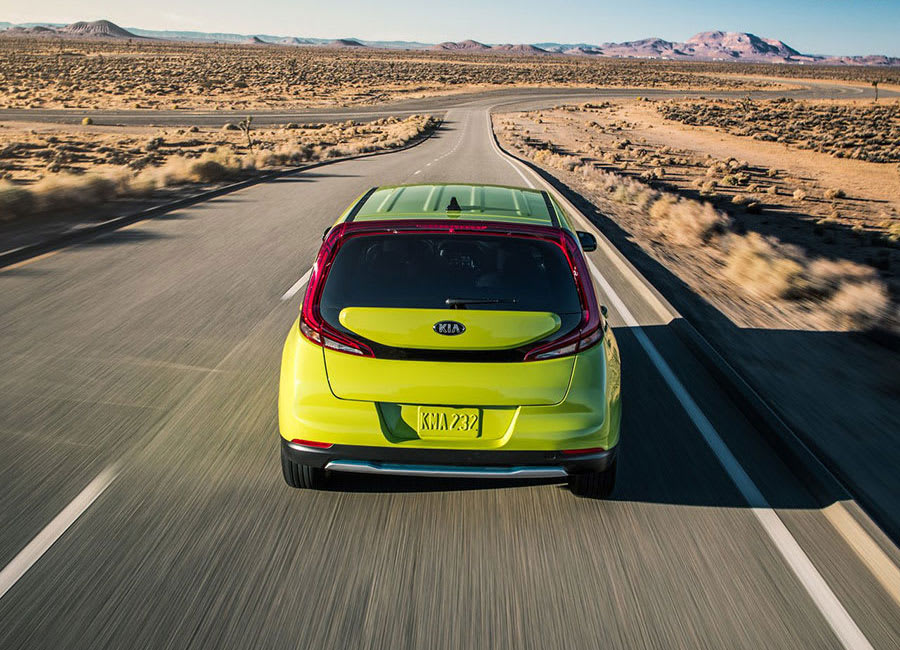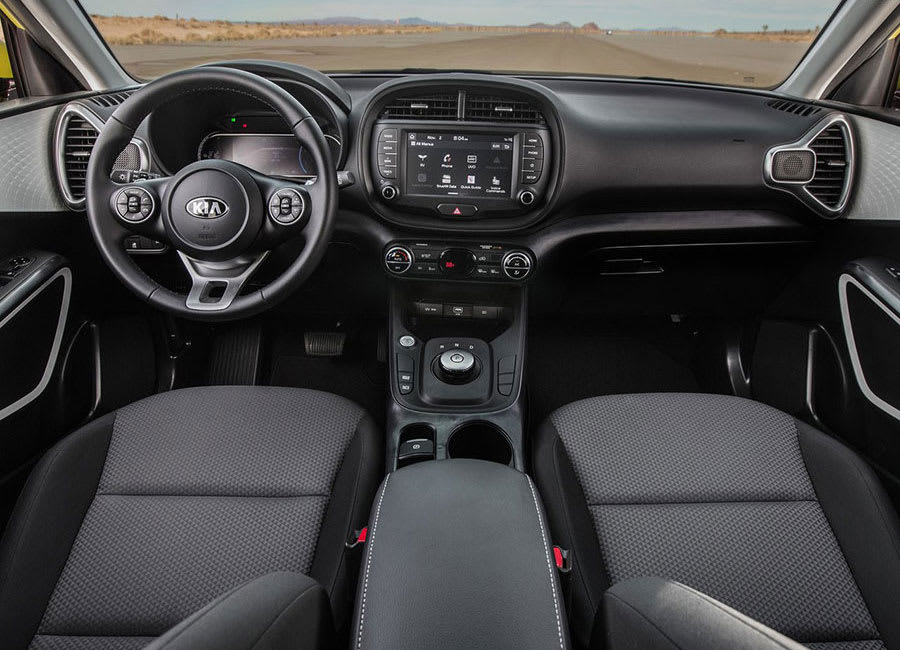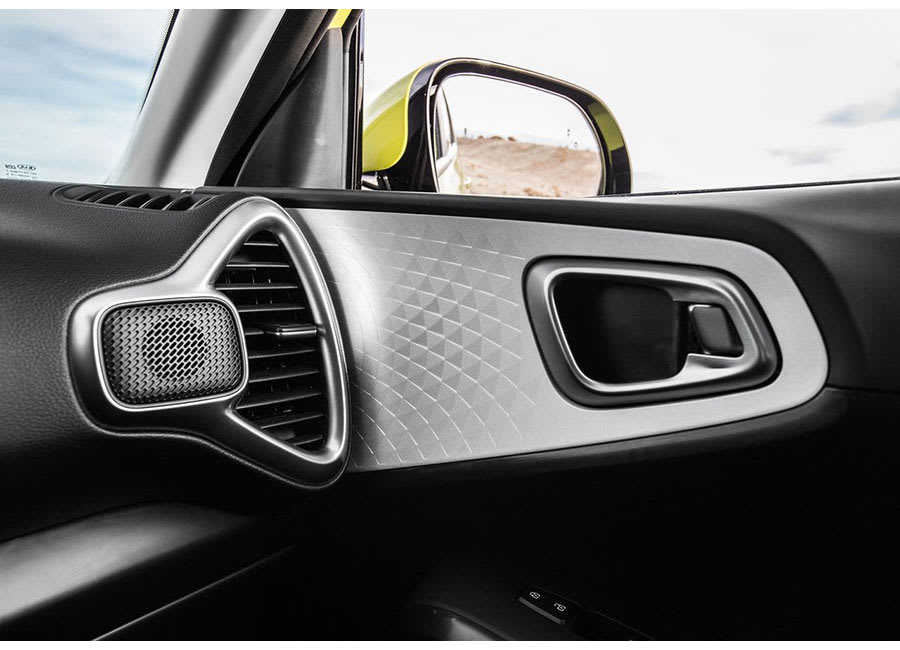
Kia Soul EV Review

Introduction
The Kia Soul is nothing if not quirky. Once designed – and we aren’t making this up – to look as though it was wearing a backpack, the left-field SUV has always done things a little differently. So perhaps it isn’t surprising that, in the UK at least, the Soul is now solely available with a battery-electric powertrain.
What you might not expect, however, is the bit that comes next. Because we think this funky, unconventional small SUV is one of the best electric cars you can lease. With a reliable range and impressive cabin quality, as well as a punchy zero-emission powertrain, South Korea’s boxy, jacked-up hatchback is up there with the very best in its class.
Review Sections
Select's rating score* - 4.1 / 5
At a Glance
Although the Soul EV’s design might not be to everyone’s taste, the South Korean compact SUV has talent in abundance. Aside from the distinctive image, the Kia offers plenty of range, a punchy electric motor and impressive build quality. And although it isn’t that big on the outside, it’s more than capable of carrying four people in relative comfort.
Add in the usual electric car bonuses, such as the quiet powertrain and the low running costs, and the Soul EV becomes rather a compelling proposition. The biggest weakness is the boot space, but as a day-to-day suburban runabout, the Soul EV has plenty going for it.
Unfortunately, its biggest rival is another Kia model – the e-Niro – and that’s more practical, more grown-up and less divisive to look at. It’s also slightly more comfortable and has slightly more range, and both traits play well with customers. Nevertheless, the Soul EV runs the e-Niro close, and the bolder styling will attract as many customers as it repels.
Key Features
There’s a clue to the Soul EV’s most important feature in its name. EV stands for electric vehicle, and the Soul comes with a very impressive, all-electric powertrain. Not only do you get a massive battery that will take you up to 280 miles between visits to the charging point, but you get a potent, silent electric motor to power you along.
That, combined with the Kia’s softly styled dashboard, high-quality cabin and impressive soundproofing, makes it an incredibly relaxing car. It’s a little haven of peace in the middle of an increasingly angry and crowded road network. Supportive seats, soft suspension and the clear, uncluttered digital screens make you feel as though you’re riding around in some kind of high-tech, futuristic and immensely comfortable pod.

Range & Batteries
The Soul EV comes with a 64 kWh battery pack as standard, and that gives you an all-electric range of up to 280 miles. Of course, that’s an official figure and it depends on a million and one different things. Weather, temperature and driving styles will all take their toll on the range, but you should be able to regularly manage more than 200 miles between charges. That’s more than you’ll get from many of the Kia’s competitors, and it makes the Soul EV incredibly usable.
Performance & Drive
With the Soul EV range offering little in the way of choice, every model drives in much the same way. And by that we mean ‘very well’. The 204hp electric motor is punchy and powerful at pretty much any speed, so you get a real shove in the back when you put your foot down. It’s no surprise to find a 0-62mph time of under eight seconds.
That makes the Soul EV nippy in its natural habitat – a town centre. You can take it on the motorway very easily; it’s very quiet and refined in the cruise, but it’s at its best in a world of junctions and pedestrian crossings. The electric motor allows you to dash away from the lights, and that’s handy if you ever find yourself in the wrong lane. And with no gears, no clutch and only a faint hum from the motor, it’s surprisingly relaxing when you’re just crawling through the traffic.

Urban environments also allow you to make the most of the Soul EV’s regenerative braking system, which harvests the energy that would ordinarily be lost while decelerating. It uses that energy to top up the battery, extending your range very slightly every time you brake or slow down. It’s so efficient, Kia reckons the Soul EV’s range grows from 280 miles to 402 miles if you only drive in city-centre traffic.
That sounds a bit optimistic to us, but there’s no doubting the fact you’ll make the most of your electrons in town. Driving at high speed tends to mean the Kia eats through electricity at a slightly faster rate, so it’s at its most frugal (and therefore most cost-effective) in the urban jungle.
Given the performance, though, you’d be forgiven for thinking the Soul EV can cut it as a sporty SUV. But on good roads it feels a little too numb and detached to provide any real enjoyment or engagement. It’s all down to that tall body, soft suspension and light steering, all of which work brilliantly in town (sensing a theme yet?), but don’t offer much in the way of sporting ability.

But then few people will lease the Soul EV as a replacement for a Mazda MX-5 or a Porsche 718 Boxster. This is a cheap-to-run and fun-to-look-at SUV for the school run, work commute or trips to the shops, and it’s perfectly suited to those tasks.
Charging
If you have off-street parking and space for a charging point, it’s best to charge at home as much as you possibly can. Not only is it better for your wallet, but it’s also better for the battery, which will suffer from too many rapid charges. However, Kia says charging the Soul EV from 0-100% using a 13-amp, three-pin socket will take 29 hours, and that’s quite a while. If you have a 7.2kW wall box installed, that will drop to around nine-and-a-half hours.
When you’re on the move, charging from 0-80% using a 50kW fast charging point will take around an hour and 15 minutes, while using a 100kW charger cuts that time to 54 minutes. That’s longer than some competitor models, but you could get around 200 miles of range in that time – not bad going.
Running Costs & Emissions
Should you have a drive and a home charger, you’ll find the Soul EV an incredibly cheap car to run – particularly if you’re coming from a non-hybrid petrol or diesel car. Assuming your electricity tariff offers a decent off-peak rate, you’ll spend very little topping the car up. But if you use public chargers regularly, consider joining some charging schemes that drop the price significantly. Those charging points can be more expensive than you might think.

Even so, the Soul EV is likely to save you money, and it’ll be particularly cheap if you’re a company car driver. With tax rates based on vehicle emissions, the zero-carbon Soul will see you pay just 1% in Benefit-in-Kind tax in the 2021/22 financial year. That’s a vast saving compared with a conventional petrol or diesel model.
Interior & Technology
Although the Soul EV is distinctive from the outside, the cabin is slightly more conventional. But although it may not be particularly inspiring, nor is it dull. You get a big touchscreen infotainment system in the middle of the dash, and everything looks rounded and modern.
But the impressive bit is the quality. The plastics are generally very good and the switchgear all feels pleasantly solid – all the stuff you expect from Volkswagen, rather than a South Korean car maker. Kia has upped its game in recent years, and the Soul EV is up there with the most impressive models in the range.

That said, the on-board technology is good, too. The Soul EV doesn’t pretend to lead the market in terms of innovation or forward-thinking, but it does the simple things really well. The standard-fit digital instrument display doesn’t have all the fancy functionality of Audi’s Virtual Cockpit, but it’s clear, easy to read and even easier to use. And when all’s said and done, that’s what really matters.
Similarly, the touchscreen infotainment system is clear and logically laid out, which means it provides maximum functionality in exchange for minimum fuss and distraction. The graphics may not be as inspiring as those on a Volkswagen, but the Soul’s touchscreen works properly, with sensible menus and buttons. That makes it less infuriating than some of the screens currently leaving the VW factory.

And it isn’t like Kia has managed this through the use of bargain-basement tech. The Soul EV comes with UVO Connect smartphone app technology as standard, which means you can lock the doors, check the battery charge and even find out where you parked using the Kia app on your phone.
Practicality & Boot Space
Although the Soul EV has compact external dimensions, it feels quite roomy inside. The front seats have acres of space and plenty of adjustability, which means you’ll have no trouble getting comfortable. Space in the back is good, too, with enough head- and leg-room to enable six-foot adults to sit comfortably.
In the boot, things are marginally less rosy. Officially, the Soul EV has a 315-litre luggage bay, which is a little small when compared with other vehicles in the class. The Seat Arona is, admittedly, powered by petrol, but it has a 400-litre load bay. Nevertheless, the Soul EV has as much space as most compact hatchbacks, and you don’t get many complaints about the practicality of the Vauxhall Corsa or Ford Fiesta.
Safety
The current-generation Soul EV hasn’t yet been crash-tested by Euro NCAP, but we have no reason to believe it wouldn’t perform admirably. The old car managed a respectable four-star rating, and the new model comes with more safety equipment as standard. Along with the traditional array of airbags and crumple zones and other ‘passive’ safety features, the current Soul has a wealth of ‘active’ safety technologies designed to prevent accidents happening in the first place.

As standard, you get lane-keeping assistance that helps to prevent the car wandering out of its lane, while the collision avoidance technology will automatically hit the brakes if the driver does not respond to a hazard. In addition, the Soul EV also comes with blind-spot detection, which tells you if there’s a vehicle lurking in the blind spots over your shoulders. Or, if you’re unsighted while reversing out of a parking space, it’ll tell you if there’s a car approaching unseen.
Options
There’s just one version of the Soul EV available at present, and that’s the high-specification Maxx model. A recent replacement for the outgoing First Edition car, the Maxx comes with 17-inch alloy wheels, full LED headlights and leather upholstery.
It also includes a 10-speaker Harmon/Kardon sound system and a 10.25-inch touchscreen infotainment system with satellite navigation. Better still, ‘keyless’ entry and engine starting, heated front seats and a heated steering wheel are also thrown in. All in all, it’s a healthy list of standard features.

To that, you can add a choice of colour schemes including three different two-tone options. Perhaps the most classic choice is the Neptune Blue with the black roof, but you can also have Cherry Red bodywork and the black roof. Or, if you’d rather, you can have the Cherry Red paint on the roof and the black paint on the body. Alternatively, just have the standard single-tone Snow White Pearl colour scheme.
And the options list includes a range of accessories designed to make life with the Soul even more comfortable. You can have LED footwell illumination in various colours, or you can go for the rear-seat entertainment cradle or even a coat hanger on the back of the seats.
Rival Cars
The Soul EV has plenty of competition, with small, electric SUVs seemingly turning up week by week. The rate at which new models seem to arrive is mind-boggling. Whereas the Soul EV was more or less unchallenged when it first arrived in the UK, it now faces rivals including the accomplished Hyundai Kona Electric and the much-improved Vauxhall Mokka-e.
Other zero-emission challengers include the surprisingly competent MG ZS EV, the stylish Mazda MX-30 and the cool new Citroen e-C4. In fact, France is a hotbed of Soul rivals, with the Peugeot e-2008 providing a funky alternative to the already quite funky Soul, and the DS 3 Crossback E-Tense offering something with some slightly more premium aspirations.

But the Soul EV’s biggest rival is arguably its electrically-powered sister, the e-Niro. Both are brilliant in their own ways, with the e-Niro offering a more grown-up vibe than its slightly smaller sibling. The e-Niro is more spacious and more useful, but for urban driving, the Soul offers more compact dimensions.
However, the Soul EV isn’t just competing with other electric cars. It vies for attention alongside other, more conventionally powered models, too. And that means you could also consider the Skoda Kamiq, Seat Arona and Renault Captur, as well as the petrol- and diesel-powered versions of the aforementioned electric models.
Verdict & Next Steps
The Soul EV is one of our favourite compact electric cars, thanks in no small part to that impressive 204hp motor. The battery is bigger than most cars in this class, too, and that makes the Kia a really usable alternative to other urban runabouts. And there’s no denying that cars such as this are generally well suited to battery power. Add in the Soul’s myriad other attributes, including solid cabin quality and radical but somehow still inoffensive looks, and you’ve got a really appealing EV.
Where to next?
View latest Kia Soul EV leasing deals - guide price from £299.33 per month inc VAT**
Looking for a great leasing deal? Check out our incredible range of car lease deals
New electric vehicle? Read our latest Reviews and find the right model for you
Want to know more about leasing? Take a look at our comprehensive Leasing Guides
Interested in everything motoring? Why not catch up on all the latest Car Leasing News.
*Score based on Select’s unique meta score analysis, taking into account the UK’s top five leading independent car website reviews of the Kia Soul EV
**Correct as of 14/09/2021. Based on 9 months initial payment, 5,000 miles over a 48 month lease. Initial payment equivalent to 9 monthly payments or £2693.93 Ts and Cs apply. Credit is subject to status.





















